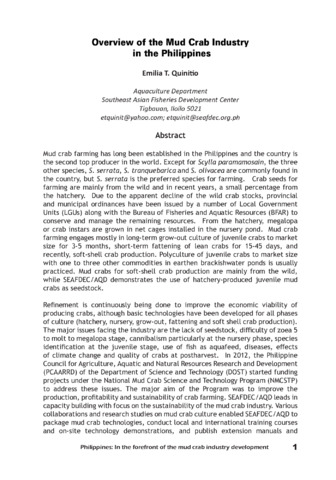Perlihatkan publikasi sederhana
Extension of nursery culture of Scylla serrata (Forsskål) juveniles in net cages and ponds
| dc.contributor.author | Rodriguez, Eduard M. | |
| dc.contributor.author | Parado-Estepa, Fe D. | |
| dc.contributor.author | Quinitio, Emilia T. | |
| dc.date.accessioned | 2014-05-21T08:59:39Z | |
| dc.date.available | 2014-05-21T08:59:39Z | |
| dc.date.issued | 2007 | |
| dc.identifier.citation | Rodriguez, E. M., Parado-Estepa, F. D., & Quinitio, E. T. (2007). Extension of nursery culture of Scylla serrata (Forsskål) juveniles in net cages and ponds. Aquaculture Research, 38(14), 1588-1592. | en |
| dc.identifier.issn | 1355-557X | |
| dc.identifier.uri | http://hdl.handle.net/10862/2070 | |
| dc.description.abstract | To address the preference of mud crab farmers for larger size Scylla serrata juveniles (5.0–10 g body weight or BW; 3.0–5.0 cm internal carapace width or ICW), a study was conducted to compare the growth and survival of crab juveniles (2.0–5.0 g BW; 1.0–3.0 cm ICW) produced a month after stocking of megalopae in net cages when reared further in net cages installed in earthen ponds or when stocked directly in earthen ponds. In a 3 × 2 factorial experiment, three stocking densities (1, 3 and 5 ind m−2), two types of rearing units (net cages or earthen pond) were used. Megalopae were grown to juvenile stage for 30 days in net cages set inside a 4000 m2 brackishwater pond and fed brown mussel (Modiolus metcalfei). Crab juveniles were then transferred to either net cages (mesh size of 1.0 mm) or earthen ponds at three stocking densities. After 1 month, no interaction between stocking density and rearing unit was detected so data were pooled for each stocking density and rearing unit. There were no significant differences in the growth or survival rate of crab juveniles across stocking density treatments. Regardless of stocking density, survival in net cages was higher (77.11±6.62%) than in ponds (40.41±3.59%). Growth, however, was significantly higher for crab juveniles reared in earthen ponds. The range of mean BW of 10.5–16.0 g and an ICW of 3.78–4.33 cm obtained are within the size range preferred by mud crab operators for stocking grow-out ponds. | en |
| dc.description.sponsorship | The authors wish to thank Mr. Avelino T. Triño for comments and suggestions, Ms. Lilian Gustilo and Messrs. Quirico Ganon and Rechie Andrada for their assistance during the field trials. This work was supported by the European Commission (INCO-DC) through the project grant no. ICA4-CT-2001-10022 ‘Culture and Management of Scylla species’. | en |
| dc.language.iso | en | en |
| dc.publisher | Blackwell Publishing | en |
| dc.subject | Decapoda | en |
| dc.subject | Modiolus metcalfei | en |
| dc.subject | Scylla serrata | en |
| dc.title | Extension of nursery culture of Scylla serrata (Forsskål) juveniles in net cages and ponds | en |
| dc.type | Article | en |
| dc.identifier.doi | 10.1111/j.1365-2109.2007.01725.x | |
| dc.citation.volume | 38 | |
| dc.citation.issue | 14 | |
| dc.citation.spage | 1588 | |
| dc.citation.epage | 1592 | |
| dc.citation.journalTitle | Aquaculture Research | en |
| seafdecaqd.library.callnumber | VF SJ 0823 | |
| seafdecaqd.databank.controlnumber | 2007-24 | |
| dc.subject.asfa | bottom culture | en |
| dc.subject.asfa | cages | en |
| dc.subject.asfa | crab fisheries | en |
| dc.subject.asfa | crustacean culture | en |
| dc.subject.asfa | growth rate | en |
| dc.subject.asfa | Megalops | en |
| dc.subject.asfa | pond culture | en |
| dc.subject.asfa | ponds | en |
| dc.subject.asfa | stocking density | en |
| dc.identifier.essn | 1365-2109 | |
| dc.subject.scientificName | Scylla serrata | en |
Files in this item
| Files | Size | Format | View |
|---|---|---|---|
|
There are no files associated with this item. |
|||
Publikasi ini ada di koleksi berikut
-
Journal Articles [1256]
These papers were contributed by Department staff to various national and international journals.



